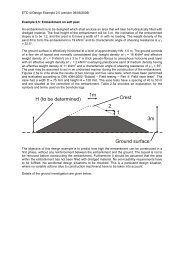Eurocode 7 designs for water pressures and review of survey
Eurocode 7 designs for water pressures and review of survey
Eurocode 7 designs for water pressures and review of survey
Create successful ePaper yourself
Turn your PDF publications into a flip-book with our unique Google optimized e-Paper software.
BP201.1BP198.1EC7 Workshop, Pavia, April 2010Water <strong>pressures</strong>Brian Simpson, Arup Geotechnicswith assistance from:Andrew Bond, Norbert Vogt, Adriaan Seters1
Three simple (????) problems• Concentrating here on safetyrelated to <strong>water</strong> pressure.• Other issues complicate mattersfurther:• DA’s, materials, resistances,calculations models2
3Extracts from EN1997-1
4Extracts from EN1997-1
Extracts from EN1997-1• DA2* - or DA1* ??5
• Method 1 – γ dst (>1) <strong>and</strong> γ stb (
Allo owable cha aracteristic FDensity <strong>of</strong> the block• Method 1 – γ dst <strong>and</strong> γ stb• W * γ +U * γ ≥ U * γ +F* γ• W γ G;stb + U stb γ G;stb ≥ U dst γ G;dst + F γ Q;dst• Method 2 – γ stb <strong>and</strong> γ stb• (W - ΔU) * γ G;stb ≥ F * γ Q;dst (buoyant weight method)• Method 3 – γ dst <strong>and</strong> γ dst• W * γ G;stb – ΔU* γ G;dst ≥ F * γ Q;dst• relative <strong>water</strong> pressure method - “single source”9
Factoring <strong>water</strong> <strong>pressures</strong>.Observation: Method 3 may be better, but still factoring the density <strong>of</strong> <strong>water</strong>.• Method 1 – γ dst <strong>and</strong> γ stb• W * γ +U * γ ≥ U * γ +F* γ• W γ G;stb + U stb γ G;stb ≥ U dst γ G;dst + F γ Q;dst• Method 2 – γ stb <strong>and</strong> γ stb• (W - ΔU) * γ G;stb ≥ F * γ Q;dst (buoyant weight method)• Method 3 – γ dst <strong>and</strong> γ dst• W * γ G;stb – ΔU* γ G;dst ≥ F * γ Q;dst• relative <strong>water</strong> pressure method - “single source”10
• Which limit states are relevant?• Sliding – GEO• Bearing capacity – GEO• Internal strength – STR• EQU? Toppling?14
WU• Do we factor <strong>water</strong> pressure?• “Single source”? Same factors on horizontal <strong>and</strong>vertical at a point?• Effect <strong>of</strong> factoring buoyant weight? γ stb (W k -U k )15
H/Bγ cct / γ w16
• Two combinations (DA1)• Same <strong>water</strong> <strong>pressures</strong> <strong>for</strong> all calculations.• Not “single source” (in any <strong>of</strong> the plots)• For all methods, results very dependent on factor values, includingmaterial or resistance factors <strong>for</strong> BC.17
• Different <strong>water</strong> <strong>pressures</strong> <strong>for</strong> each limit state?• No <strong>water</strong> <strong>pressures</strong> less than characteristic• Not simply using the most critical?18
• γ G lower <strong>for</strong> <strong>water</strong> pressure?• Water pressure less than characteristic considered• This one is “single source”.19
Example 3• How many piles?• How to computedesign BM?RWU20
ΔhW k x γ GDh kU k x γ UR k /γ Rγ G = γ F,inf or γ F,stbγ U = γ Fsup F,sup or γ dst21
ΔhW k x γ GDh kU k x γ UR k /γ R• Water head ratio• Weight ratio• Anchorage ratioh k /DW k /(vol x γ w ) nR k /W k• How much <strong>water</strong> pressure • How heavy is the building • How much anchorage22
Example 3 – Characteristic situationn Ra,k / Wkhorage ratio,AncCharacteristicweight ratio = 0,1weight ratio = 0.250.8 weight ihratio = 0.5 05weight ratio = 0.75weight ratio = 1weight ratio = 20.60.40.200 0.2 0.4 0.6 0.8Water head ratio, hk / D• Anchorage rationR k /W k• How much anchorage• Water head ratioh k /D• How much <strong>water</strong> pressure• Weight ratioW k /(vol x γ w )• How heavy is the building23
Weight ratio 0.25. Δh=0.ratio, n Ra,k/ WkAnchorage0.80.60.40.2Design with omega_W = 0.25, delta_h = 0UPL method 1, 0.9nRkUPL method 2GEO DA1-1GEO DA1-2GEO DA1-1*GEO DA2CharacteristicUPLUPLDA1-1DA1-2DA1-1*DA2*• For high <strong>water</strong> heads, allmethods give somesafety.• How much is needed?• Near the balance point,safety is only providedby increasing the <strong>water</strong>pressure.00 0.1 0.2 0.3 0.4Water head ratio, h_k / D24
Weight ratio =0.25. Δh=0.1An nchorage rati io, n Ra,k / Wk0.80.60.40.2Design with omega _ W = 0.25, delta_h = 0.1UPL method 1UPL method 2GEO DA1-1GEO DA1-2GEO DA1-1*GEO DA2Characteristic00 0.1 0.2 0.3 0.4Water head ratio, h_k / D• Increasing the headby Δh provides asafety margin.• But would this beused in addition toother safety factors?, 0.9nRkUPLUPLDA1-1DA1-2DA1-1*DA2*25
Weight ratio = 0.75 (heavy building). Δh=0.1.A nchorage rati io, n Ra,k / Wk0.80.60.40.2Design with omega _ W = 0.75, delta_h = 0.1UPL method 1UPL method 2GEO DA1-1GEO DA1-2GEO DA1-1*GEO DA2Characteristic00.5 0.6 0.7 0.8 0.9Water head ratio, h_k / D• Similar pattern.• Factoring <strong>water</strong><strong>pressures</strong> starting todominate effect <strong>of</strong>Δh., 0.9nRkUPLUPLDA1-1DA1-2DA1-1*DA2*26
Weight ratio = 0.75 - my preferenceΔh=0 0.1or γ*, 0.9nRkAn nchorage rati io, n Ra,k / Wk0.80.60.40.2Design with omega_W = 0.75, delta_h = 0.10.9 Wk, 1.0 Uk, nRk/1.60.9 Wk, 1.0 Uk0.9 Wk, 1.0 Uk, nRk/1.6, no dh0.9 Wk, 1.0 Uk, no dh1.0 Wk, 1.35 Uk, nRk/1.0, no dh1.0 Wk, 1.35 Uk, nRk/1.01.0 Wk, 1.35 Uk, nRk/1.0, no dh1.0 Wk, 1.35 Uk, nRk/1.6, no dhCharacteristic00.5 0.6 0.7 0.8 0.9Water head ratio, h_k / D• DA1-1* becomescritical <strong>for</strong> bendingmoment.0.9 Wk, 1.0 Uk, nRk/1.60.9 Wk, 1.0 Uk, 0.9nRk0.9 Wk, 1.0 Uk, nRk/1.6, no dh0.9 Wk, 1.0 Uk, no dh1.0 Wk, 1.35 Uk, nRk/1.0, no dh1.0 Wk, 1.35 1.0 Uk, nRk/1.6 nRk/1.01.0 Wk, 1.35 Uk, nRk/1.0, no dh1.0 Wk, 1.35 Uk, nRk/1.6, no dhCharacteristicUPLUPLUPLUPLDA1-1DA1-2DA1-1*DA2*27
Some thoughts• Avoid factoring <strong>water</strong> <strong>pressures</strong> – always??• Margins better than factors.• Perhaps factor differential <strong>water</strong> pressure.• Single source?• Can we retain physical reason?• Apply a lot <strong>of</strong> common sense.28








